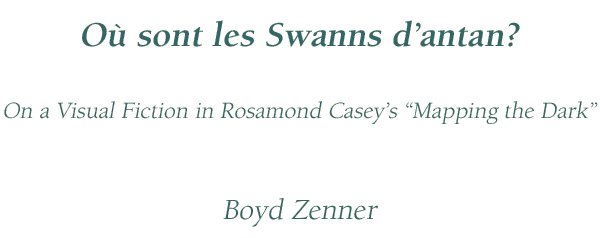|
r e s p o n s e |
b o y d z e n n e r |

|
You knew Raymond Swann, or someone like him. Everybody did. In my seventh grade class it was Carleton Grimes, he of the bulging green eyes and preternaturally square head. Generally he could be found at the rear of the classroom, slumped over his desk and staring into space as he thoughtfully mined the depths of one nostril with a stubby finger. It was remarked by many that he gave off a more or less constant low hum, like an amplifier left on overnight. One day somebody asked him what tune he was humming, and he said it was “Stranger in Paradise.” The other kid told the whole class, and everyone laughed insanely. A few years later it was Teddie Bethune. Precociously cross-dressed, he’d smooth his nyloned legs with slow, hypnotic strokes during Algebra Two while favoring the teacher with a sociable and attentive smile. Once in a while he would remove a small compact from his book bag and daub his nose and forehead with powder while the class erupted in groans of disgust. The spring of tenth grade, practically the whole school crowded into the gymnasium bleachers to watch him try out for the cheerleading squad. A few teachers looked on expressionlessly from the doorways and went away shaking their heads. None of them was what you might call one of the fellows, Carlton Grimes, Teddie Bethune, Raymond Swann. The referendum on each could be summarized as: Weird, and not in a good way. Grimes and Teddie Bethune eked out an existence as laughingstocks at the far chilly edge of the social continuum; nevertheless, there they were. Raymond Swann, on the other hand, was invisible. Now, anyone can be invisible – middle-aged women complain of it all the time – but Raymond Swann was different; a rare work of self-erasure. In memory, he exists as a defined void or cipher, the outline of a human being with nothing at all in its center. Perhaps he went out for a pack of cigarettes and forgot to return. Perhaps he signed himself into the Witness Protection Program, needing protection from – what? He nourished a secret, of course; something about a baby brother. Or it was a semi-secret, hidden in plain view because nobody could be bothered to discover it. Gradually it eroded him, and as it did, he decided he would memorialize it: Here is the boy launched into space, heels snaking twin umbilicals; here is a menacing wire coiling toward a uterine sea. Over and over, receding, he is telling his one story, and if anyone listens... But no one did. Not a brain, Raymond, but precocious – oh, more so than Teddie Bethune. He learned the art of self-mutilation long before its moment in the sun arrived, and his technique was subtle, refined – no bloody razor marks or circular burns; just disintegrating contours. You could call him a deconstructionist. Interestingly, there was no violence in the process: your hand is on someone’s shoulder, and he lifts your fingers off, gently, one by one, and you’re holding air; you let a kite string unspool until it all runs out and the kite floats off, and you can’t remember why you’re standing in the middle of a field. Here’s what we may suspect about Raymond Swann: that at a certain point, for a few days or a week or a month, everything looked different than it had before or would afterward. He might even have talked about it. He’d spent a lot of time wondering what life was like on other planets: now he’d get to find out. Might someone look up to him, and might he see himself reflected in that person’s eyes? It would almost have to be a better likeness than his secret xeroxes offered – more detailed, more convincing, more real. Ideally, the child would sleep in his, Raymond’s, own bedroom (he might have thought), so that he could look at him whenever he liked and the child would have to look back. But it didn’t turn out. Something happened, the moment passed, Raymond went back to being whatever he was, but less so. Pallid before, he became the soul of transparency and then negation. Meanwhile he worked, though not, of course, on his schoolwork. (Not a brain, remember?) People recollected his existence for a week, then a day, then an hour. Then they began to forget him as soon as they saw him. Conversely, the images piled up, road maps to a place no one was going. He did it on purpose. That’s what’s left of him now. If you were to take it into your head to visit Raymond Swann, well – you couldn’t, that’s all. You might go to his parents’ house and they’d show you his room (“Sorry, it’s kind of a mess,” they’d apologize), with its stacks of drawings and collages and xeroxes. And at the end, you wouldn’t know him any better than you do now. The kite string unspooled quite a long time ago, it appears, and a kite in the approximate shape of a person drifted slowly up, up, away from the shrinking houses and towns and roadways and into the clean white glare of the sun.
© 2003 Boyd Zenner.
See Rosamond Casey’s “The Raymond Swann Collection”
|